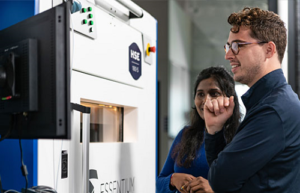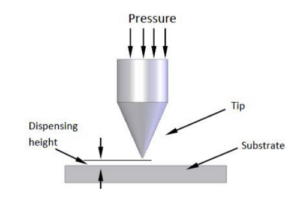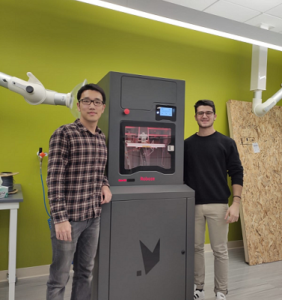In today’s 3D Printing News Briefs, we’re talking about new products and materials, an industry event, 3D printed electronics, and education. 3Doodler announced a new product, and Essentium will be showcasing two new materials at RAPID + TCT. The 4th annual AM Cluster of Ohio conference is coming up in July, and nScrypt is microdispensing 50um dots for 3D printed electronics. Finally, Penn State University is investing in Roboze technology.
3Doodler Introduces New 3D Build & Play
 At the New York Toy Fair, February 22-25 at Manhattan’s Jacob Javits Center, 3Doodler will be showcasing its latest device – the 3D Build & Play, perfect for preschoolers and kindergartners to use. The pen was designed for users as young as four years old, and introduces growing children to 3D printing technology in a way that promotes cognitive and fine motor skills development, hands-on learning, story telling, and three-dimensional thinking. The 3D Build & Play is kid-safe, extruding low-heat, BPA-free, non-toxic, biodegradable plastic, and comes with a story-based Activity Guide so parents and kids can create together. Currently available for pre-order, 3D Build & Play will have an MSRP of $29.99, and major retailers, like Amazon, are also expected to carry the product in Q2 2020. Visit 3Doodler in Booth #2771 at the New York Toy Fair to learn more.
At the New York Toy Fair, February 22-25 at Manhattan’s Jacob Javits Center, 3Doodler will be showcasing its latest device – the 3D Build & Play, perfect for preschoolers and kindergartners to use. The pen was designed for users as young as four years old, and introduces growing children to 3D printing technology in a way that promotes cognitive and fine motor skills development, hands-on learning, story telling, and three-dimensional thinking. The 3D Build & Play is kid-safe, extruding low-heat, BPA-free, non-toxic, biodegradable plastic, and comes with a story-based Activity Guide so parents and kids can create together. Currently available for pre-order, 3D Build & Play will have an MSRP of $29.99, and major retailers, like Amazon, are also expected to carry the product in Q2 2020. Visit 3Doodler in Booth #2771 at the New York Toy Fair to learn more.
“3D Build & Play brings the creative fun of our Start pen without the learning curve for the youngest users. The system we have developed, that lets kids crank and create in 3D, is a major benefit for parents looking to improve their children’s basic motor skills. The included molds make it easy to create 3D objects by simply filling and popping them out. There’s nothing on the market today that makes 3D creation this simple or fast for young creators,” said 3Doodler’s CEO Daniel Cowen.
Essentium’s New Materials for High-Temperature Applications
 At RAPID + TCT 2020 in Anaheim this spring, 3D printing solutions provider Essentium will introduce new ULTEM AM9085F and ABS materials for high-temperature industrial AM applications. These high-performance materials, which will be showcased on the company’s High Speed Extrusion platform at the event, provide high strength and have excellent resistance to heat and chemicals at high temperatures, so they can be used for applications in the aerospace, automotive, industrial, and medical industries.
At RAPID + TCT 2020 in Anaheim this spring, 3D printing solutions provider Essentium will introduce new ULTEM AM9085F and ABS materials for high-temperature industrial AM applications. These high-performance materials, which will be showcased on the company’s High Speed Extrusion platform at the event, provide high strength and have excellent resistance to heat and chemicals at high temperatures, so they can be used for applications in the aerospace, automotive, industrial, and medical industries.
According to a survey commissioned by Essentium, 51% of executives believe that the high cost of materials is a major obstacle when it comes to adopting 3D printing for large-scale production purposes. The new ULTEM AM9085F and ABS materials were created to give manufacturers a more cost-effective solution when compared to expensive closed-system materials. Learn more at Essentium’s Booth #3400 at RAPID + TCT in Anaheim, CA, April 20-23, 2020.
4th Annual Additive Manufacturing Cluster of Ohio Conference
 The Additive Manufacturing Cluster of Ohio, powered by organizations such as America Makes and the Youngstown Business Incubator, has announced that its 4th annual conference will take place this summer in Cleveland. Cluster members work together to create a supply chain of interconnected institutions and businesses to advance regional growth in 3D printing. This conference, to be held on Thursday, July 30, at the Embassy Suites by Hilton Cleveland Rockside, will be the first cluster event of 2020, and will give Ohio manufacturers of multiple business models and sizes perspectives on available opportunities for adopting 3D printing into their process chain over the next five years.
The Additive Manufacturing Cluster of Ohio, powered by organizations such as America Makes and the Youngstown Business Incubator, has announced that its 4th annual conference will take place this summer in Cleveland. Cluster members work together to create a supply chain of interconnected institutions and businesses to advance regional growth in 3D printing. This conference, to be held on Thursday, July 30, at the Embassy Suites by Hilton Cleveland Rockside, will be the first cluster event of 2020, and will give Ohio manufacturers of multiple business models and sizes perspectives on available opportunities for adopting 3D printing into their process chain over the next five years.
The website states, “The program will look at similarities and differences across several selected manufacturer types and will identify strategies ranging from low to high risk. Attendees will leave with actionable strategies and information about regional resources to help them remain competitive in the evolving manufacturing landscape.”
nScrypt Working with 3D Printed Electronics
 Orlando company nScrypt is working with precision microdispensing, an additive method of dispensing pastes, inks, and other fluid materials, to create adhesive dots with volumetric control, in the 50 micron range, for 3D printed electronics and flexible hybrid electronics (FHE). Microdispensing gets much closer to the substrate surface when compared to methods like jetting, and the closer the nozzle is to the surface, the finer the features of the 3D printed parts. The team used the nScrypt SmartPump, a silicone adhesive, a conical pen tip, and Heraeus SAC305-8XM8-D Type IX solder paste, and tested the consistency and repeatability of ~50µm Type IX solder and adhesive dots.
Orlando company nScrypt is working with precision microdispensing, an additive method of dispensing pastes, inks, and other fluid materials, to create adhesive dots with volumetric control, in the 50 micron range, for 3D printed electronics and flexible hybrid electronics (FHE). Microdispensing gets much closer to the substrate surface when compared to methods like jetting, and the closer the nozzle is to the surface, the finer the features of the 3D printed parts. The team used the nScrypt SmartPump, a silicone adhesive, a conical pen tip, and Heraeus SAC305-8XM8-D Type IX solder paste, and tested the consistency and repeatability of ~50µm Type IX solder and adhesive dots.
These tests showed a consistent average dot diameter of 51.24 microns, with a 6.42 micron (13%) standard deviation. These results support the fabrication of 3D printed electronics through the use of direct digital manufacturing (DDM), which allows printing to both planar substrates and the non-planar world of Printed Circuit Structures, which prints the housing or structure of an electronic device as well as placing the electronics conformally. In the future, the team plans to conduct a larger solder and adhesive dot study, in order to test required downtime, long-term reliability, and the frequency of clogging.
Penn State University Invests in Roboze Technology
 Penn State, a 3D printing leader through its Center for Innovative Materials Processing through Direct Digital Deposition (CIMP-3D), has invested in a new FFF solution in order to expand its AM capabilities. The ROBOZE One+400 Xtreme 3D printer, which was designed to create high performing, functional finished parts in advanced composite materials, will help the university increase its development of high performance plastics for 3D printing, and will be housed in the Department of Chemical Engineering. Students will be able to test out new polymers on the system, and develop new formulations to provide 3D printed parts with multi-functionality. These parts will be used to advance research in applications like chemical reactors.
Penn State, a 3D printing leader through its Center for Innovative Materials Processing through Direct Digital Deposition (CIMP-3D), has invested in a new FFF solution in order to expand its AM capabilities. The ROBOZE One+400 Xtreme 3D printer, which was designed to create high performing, functional finished parts in advanced composite materials, will help the university increase its development of high performance plastics for 3D printing, and will be housed in the Department of Chemical Engineering. Students will be able to test out new polymers on the system, and develop new formulations to provide 3D printed parts with multi-functionality. These parts will be used to advance research in applications like chemical reactors.
“ROBOZE One+400 Xtreme will be used to examine novel polymers to help to fundamentally understand the 3D printing process and as a tool to enable custom equipment more cost effectively than can be obtained with machining metals while also allowing for designs not possible with traditional manufacture. The ROBOZE One+400 Xtreme will allow Penn State to leverage its expertise in materials science, engineering and characterization to enable new solutions to problems through additive manufacturing,” said Professor Bryan D. Vogt from the Department of Chemical Engineering.
“The ability to use custom filaments and control the print processing was a critical factor in selecting ROBOZE. The flexibility allowed by ROBOZE along with its excellent printing capabilities is well aligned with the discovery-oriented research mission of the university to expand knowledge and its application. Moverover, our prior 3D printer had issues printing high temperature engineering plastics like PEEK with severe deformation of the structure generally observed. After challenges with printing PEEK with standard belt driven systems, the novel direct drive approach with the ROBOZE was an added bonus.”
Discuss these stories and other 3D printing topics at 3DPrintBoard.com or share your thoughts in the Facebook comments below.
Subscribe to Our Email Newsletter
Stay up-to-date on all the latest news from the 3D printing industry and receive information and offers from third party vendors.
You May Also Like
3D Printing Webinar and Event Roundup: April 7, 2024
Webinars and events in the 3D printing industry are picking back up this week! Sea-Air-Space is coming to Maryland, and SAE International is sponsoring a 3D Systems webinar about 3D...
Roboze Brings Performance Polymer 3D Printing to SoCal via New Partnership
High-performance polymer 3D printing firm Roboze has been steadily working to expand its global footprint, with a firm eye on distributed manufacturing, particularly with regard to the oil and gas,...
3D Printing Webinar and Event Roundup: March 3, 2024
In this week’s roundup, we have a lot of events taking place, including SPE’s ANTEC 2024, Futurebuild, the AAOP Annual Meeting, JEC World, and more. Stratasys continues its training courses,...
Advanced Manufacturing Firm Zeda Acquires The Orthopedic Implant Company
Zeda, the San Francisco-based provider of advanced manufacturing solutions, announced that it has acquired The Orthopedic Implant Company (OIC), a medical device manufacturer based in Reno, Nevada, for an undisclosed...































